Holly Gets Help – UPDATE April 10, 2014
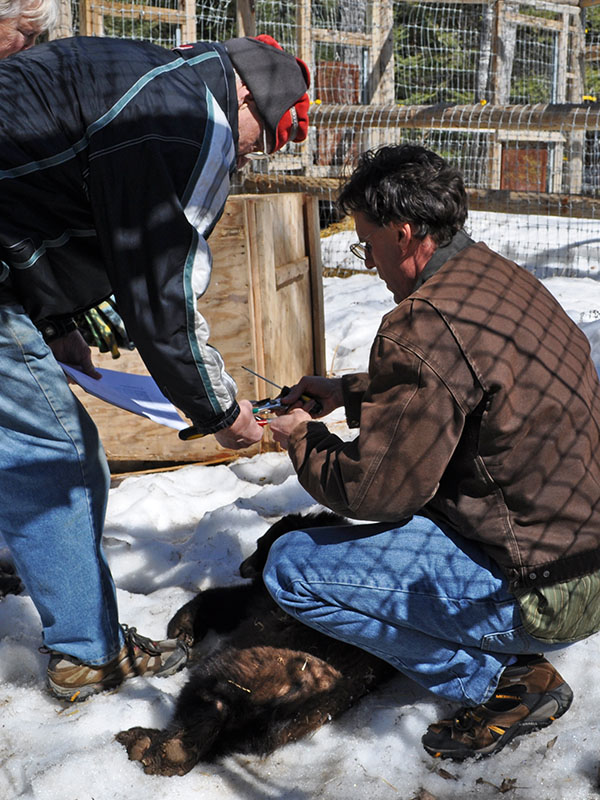 Lynn and Dr Hansen prepare
Lynn and Dr Hansen prepare
to work on HollyA little before 1 PM today, veterinarian Dr. Chip Hansen used a tiny needle to gently administer a minimum dose of tranquilizer that has both anesthetic and pain-killing properties. The dose would keep Holly immobilized for only about 20 minutes, so he had to work fast.
 Removing left ear tagHe immediately began removing Holly’s ear tags. One had stayed in place but the other had nearly torn out. The left ear that had been bent over by the weight of the metal tag can now stand up nearly straight, and the torn right ear can begin healing.
Removing left ear tagHe immediately began removing Holly’s ear tags. One had stayed in place but the other had nearly torn out. The left ear that had been bent over by the weight of the metal tag can now stand up nearly straight, and the torn right ear can begin healing.
Dr. Hansen then shaved around a festering wound of unknown origin on the left side of her rump. Dr. Hansen prescribed a course of antibiotics that can be given as part of her formula.
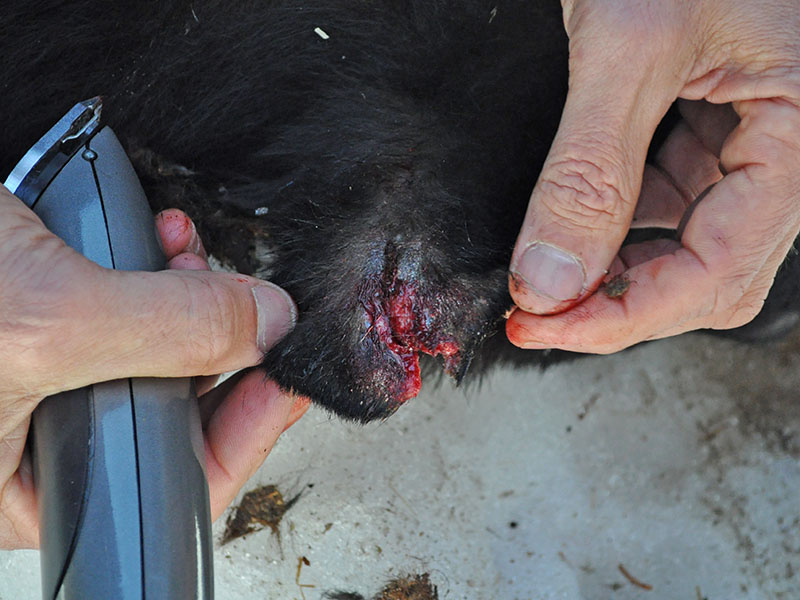 Right ear splitNext he shaved a spot just above Holly’s ankle and took a blood sample that will be analyzed over the next few days.
Right ear splitNext he shaved a spot just above Holly’s ankle and took a blood sample that will be analyzed over the next few days.
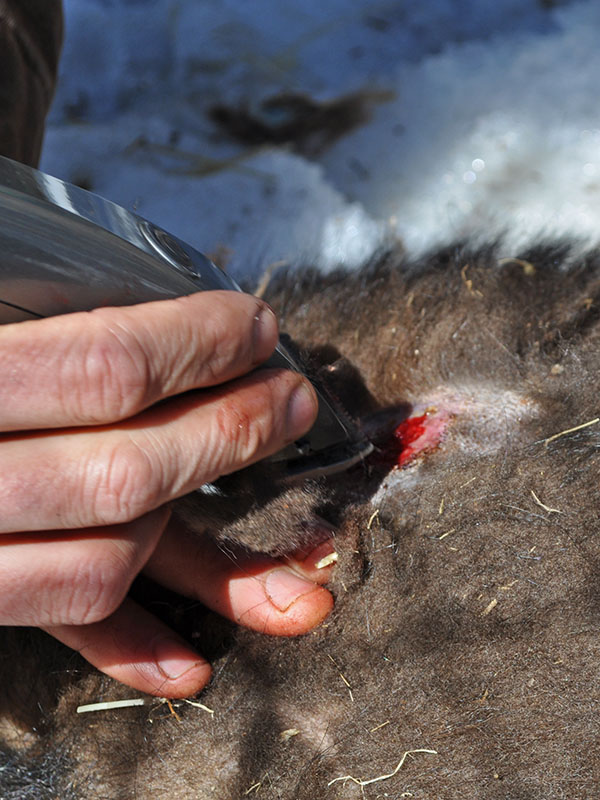 Shaving around woundDr. Hansen checked Holly’s gums (nice and pink) and tooth development, which is well advanced for her age. She apparently was fed well by the people who cared for her. At her age, many bears in the wild still have their baby canine teeth, especially after a year of scarce food. With better food, some yearlings have loose canines that are being pushed out by the adult canines, or have canines that have erupted farther. Holly’s baby canines were pushed out long ago, and her adult canines are over ¾ inch long. Her body length from the tip of her nose to the base of her tail is 37 inches.
Shaving around woundDr. Hansen checked Holly’s gums (nice and pink) and tooth development, which is well advanced for her age. She apparently was fed well by the people who cared for her. At her age, many bears in the wild still have their baby canine teeth, especially after a year of scarce food. With better food, some yearlings have loose canines that are being pushed out by the adult canines, or have canines that have erupted farther. Holly’s baby canines were pushed out long ago, and her adult canines are over ¾ inch long. Her body length from the tip of her nose to the base of her tail is 37 inches.
 Holly's canineHer old footpads are nicely shed and the new pads are smooth. She apparently will have no trouble shedding her footpads.
Holly's canineHer old footpads are nicely shed and the new pads are smooth. She apparently will have no trouble shedding her footpads.
 Holly's front footpadAs Holly recovered, Lynn offered her a bottle, which she immediately recognized and began licking. As bears recover, they are prone to a lot of side-to-side head movement, so at first she only licked the nipple when she moved her head in that direction. Then she began to actually suckle. Lynn started getting her used to touch with slow, gentle but firm strokes down her spine. When she accepted that, he extended the strokes to start on her head, continuing down the length of her back. When she became mobile, she moved to the quiet security of her den.
Holly's front footpadAs Holly recovered, Lynn offered her a bottle, which she immediately recognized and began licking. As bears recover, they are prone to a lot of side-to-side head movement, so at first she only licked the nipple when she moved her head in that direction. Then she began to actually suckle. Lynn started getting her used to touch with slow, gentle but firm strokes down her spine. When she accepted that, he extended the strokes to start on her head, continuing down the length of her back. When she became mobile, she moved to the quiet security of her den.
 Dr Hansen draws bloodAbout 6 PM, she came out to the fence for a bottle.
Dr Hansen draws bloodAbout 6 PM, she came out to the fence for a bottle.
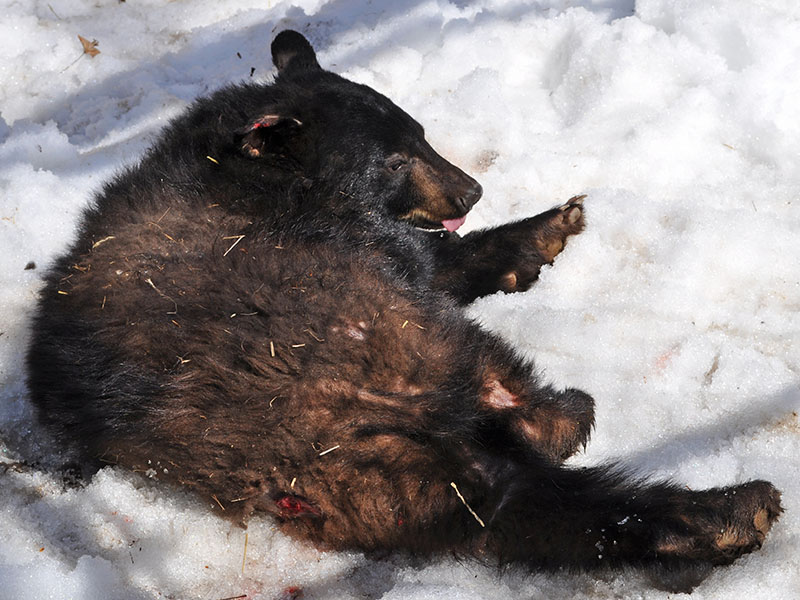 Holly recoversThe whole exam went very well. The tranquilizer dose was perfect. Dr. Hansen accomplished all that we had hoped, and Holly was already beginning to be active as he finished.
Holly recoversThe whole exam went very well. The tranquilizer dose was perfect. Dr. Hansen accomplished all that we had hoped, and Holly was already beginning to be active as he finished.
We saw a nice article in a Virginia newspaper about hibernation at http://tinyurl.com/lx5womk. We had a nice talk with the author as she was writing it a couple days ago. She covered a lot.
 Lynn strokes HollyOn another note, Lily Fans are making a big difference for the development of the Ecology Exhibit. Thanks to their suggestions, the exhibit can be more attractive and interactive that we initially envisioned. We showed our age in suggesting a scrapbook to hold the compiled wildlife information. A Lily Fan suggested a touch-screen TV. A natural. We have long wanted more to engage 8-12-year-olds. This will engage all ages. We also want to make the compiled information available on bear.org.
Lynn strokes HollyOn another note, Lily Fans are making a big difference for the development of the Ecology Exhibit. Thanks to their suggestions, the exhibit can be more attractive and interactive that we initially envisioned. We showed our age in suggesting a scrapbook to hold the compiled wildlife information. A Lily Fan suggested a touch-screen TV. A natural. We have long wanted more to engage 8-12-year-olds. This will engage all ages. We also want to make the compiled information available on bear.org.
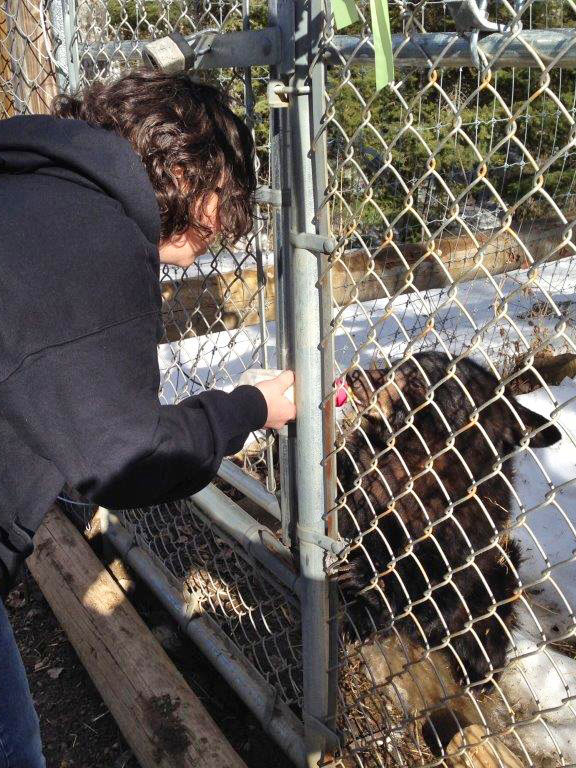 Heidi gives Holly formulaSomeone else suggested greatly expanding the habitat exhibit to encompass a whole 40-foot wall and extend about 15 feet out from the wall. The huge exhibit can hold many of the mammals and birds you are helping us obtain. Many of the animals and birds will not immediately be apparent. An undulating knee-wall can include some information and have a push-button by the name (and picture) of each species. Pushing the button will turn on a small light next to the mammal or bird. The undulating knee-wall will let visitors become a little more immersed in the exhibit.
Heidi gives Holly formulaSomeone else suggested greatly expanding the habitat exhibit to encompass a whole 40-foot wall and extend about 15 feet out from the wall. The huge exhibit can hold many of the mammals and birds you are helping us obtain. Many of the animals and birds will not immediately be apparent. An undulating knee-wall can include some information and have a push-button by the name (and picture) of each species. Pushing the button will turn on a small light next to the mammal or bird. The undulating knee-wall will let visitors become a little more immersed in the exhibit.
The habitat can be of several types, including a tall rock outcrop and a circulating stream and pond. It will include both forest and openings, upland and lowland. We’ll need volunteers to help create it. We’ll need volunteers to compile the information based on an outline we and volunteers are creating.
Most of the newly sponsored taxidermy mounts will arrive Saturday, April 12. Some are asking when more taxidermy will be listed for sponsorship. We are still working on a way to get the birds and small mammals mounted. More on this later.
Thank you for all you do.
—Lynn Rogers and Sue Mansfield, Biologists, Wildlife Research Institute and North American Bear Center
